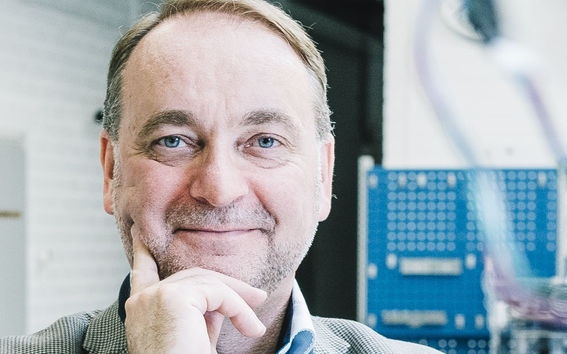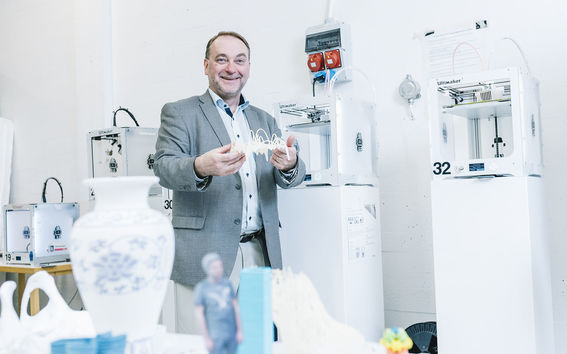Jukka Tuomi was a pioneer in 3D knowledge

Does 3D printing revolutionize our world?
Production techniques are typically based on material removal methods such as turning, milling and grinding, and materials-forming methods such as casting. The former were developed during the Stone Age, 40 000 years ago. Methods of shaping the material were invented during the copper age, about 7 000 years ago. Now, less than 30 years ago, we have begun to develop methods that increase material. So we are witnessing a major change in the production of goods. This does not eliminate old methods, but complements them. But the challenge is to adapt to change.
You are the first Finn in history to have his face printed in 3D. What was this for?
The case involved medical need. I served as a model in 2013, when preparations for the first Finnish facial transplant operation were being made. Photographs were taken of different segments of my face and these were then reconstructed into a 3D model, which was printed using composite plaster in a few hours.
3D printing is also referred to as rapid manufacturing, but that actually sounds pretty slow.
The pace depends on the quality of the printer and on how many pieces are being made simultaneously. When manufacture takes place layer by layer, it is possible to add about one centimetre of material each hour. This is of course quite slow if you are comparing with traditional mass production techniques.
Do you have a 3D printer at home?
No, and I haven’t even considered getting one. Some people think that 3D printers could be useful at home. You might use them to make spare parts and other utensils, for example. I’m of a school of thought that does not believe in this. Furthermore, desktop printers meant for home users that cost less than €5 000 often produce objects of poor quality.
The ability to print some lump of mass yourself as a hobby can be fun. And also pretty effortless, when you don’t have to think about the necessary tools and methods like drilling and turning. You just enter an electronic model file into the 3D printer, and it will print an object of more or less the same appearance.
This type of hobby is educational, provides experience and connects the virtual world with the physical realm. And there are no drawbacks, unless you count possibly consuming non-renewable natural resources to make objects, which may never be used. I myself have many items like that in my office and with me in my briefcase. They are demonstrations of what is possible.
Have you not printed anything for use at home?
I did seriously consider doing it once, when a sprocket broke in my food processor. There would have been printers at work, but I decided to be more reasonable and popped into the shop for a spare part. I bought the €15 plastic part off the shelf. Had I opted to use a 3D printer, the price would have been at least ten times higher, and there would have been no guarantee of durability.
But I do have one printed item in use. It is attached to my golf bag and I use it to hang my towel on. The clip in question is quite well made. There might also be some 3D printed parts in my car.
It is also possible that many of us are using industrially printed products without knowing about them. The world’s first 3D printer was sold in 1988 and they have been used in industry ever since then.
What’s the dumbest, most useless 3D object?
I’ve seen a fipple flute that was 3D printed so poorly that no factory in any part of the world would manufacture such a thing. I’m amazed to see even quite prestigious media outlets speculate about the printing of, for example, Stradivarius violins. The idea that you could make anything like that by printing is just bonkers. It might very well be the height of hype.
And what about the most dangerous application?
I’ve heard of people printing plastic anti-slip footwear attachments. These should not be made at home, and certainly not from plastic. And a 3D printed gun can be extremely dangerous – to its user as well.
These days plastic is the primary raw material for printing. When will users get their hands on harder materials?
It is a misconception that only plastic is used in printing. This is true for home printers, but metals are already used to a substantial degree in industry. Aircraft components, for example, can be made with 3D printers and medical equipment is made from titanium. But this is only complementing older manufacturing methods, not replacing them.
Will we be printing food any time soon?
We do have a current research project studying this question. The “meat of the matter” involves the ability to precisely tailor nutritional contents and values. It might, for example, be desirable to supply people, who have special dietary needs, with vending machines that offer tailor-made meals.
What’s the best thing you can do with this method?
In the field of medicine, we’ve been able to provide assistance to physicians caring for patients. For example, we supplied a children’s hospital with model spines to facilitate the planning of treatment for a difficult case of scoliosis. The first titanium implant given to a Finnish patient was also designed by an Aalto research group. The orbital floor implant in question was manufactured as a thesis work project.
Generally speaking, we’ve managed to develop treatment processes in cooperation with physicians, but we also help companies make ever better and more competitive products.

Jukka Tuomi (16.1.1963–11.4.2019) worked as Research Director of 3D Printing at the School of Engineering. He was a graduate of the Helsinki University of Technology and Doctor of Science (Technology) of Aalto University. The dissertation published in 2018 deals with medical applications of 3D printing.
Jukka Tuomi was one of the leading experts in the field. He was familiar with CAD technology and 3D modeling already during his studies in the 1980s and deepened his skills at the Fraunhofer research institute in Germany. His special interest was in utilising 3D applications in industry and medicine.
Tuomi was also an active organisational actor both in Finland and internationally. He was a founding member of the Finnish Rapid Prototyping Association and had been chairing it for over 20 years.
Text: Paula Haikarainen.
This article is originally published in the Aalto University Magazine issue 20, October 2017.
Read more news

Seizing opportunities
Vuong Vo's path led through Aalto University and VTT to a startup, where he is helping build the protein factory of the future.Growing Materials, Growing Ideas: Inside the BioMaker Studio
At Aalto University’s BioMaker Studio, initiated by Ena Naito, students and researchers experiment with living materials, from algae to mycelium, creating an open, interdisciplinary space where design, biology, and collaboration grow together.
Your voice gives away valuable personal information, so how do you keep that data safe?
With speech technologies becoming increasingly common, researchers want to make sure we don’t give away more information than we mean to.






